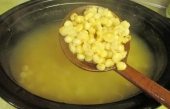
 4
4




 1
1




 3
3




 3
3




 2
2















 10
10




 4
4




Larisa Walk wrote:I've gotten too lazy to make tortillas from our flint polenta corn. I just cook it into hominy and use it whole with beans and salsa and chopped greens to make a deconstructed bean tortilla. It tastes the same flavor-wise with lots less effort. BTW, I've also nixtamalized popcorn and sorghum as well as flour and dent corns and made decent tortillas from all of them. They're just different flavors and textures, but all quite tasty.
"We're all just walking each other home." -Ram Dass
"Be a lamp, or a lifeboat, or a ladder."-Rumi
"It's all one song!" -Neil Young
 6
6




 8
8




Thom Bri wrote:
Try a southwest US or a Mexican variety.
 4
4




Donn Cave wrote:
Thom Bri wrote:
Try a southwest US or a Mexican variety.
I'm back with the results of that - I grew some green Oaxacan, and made these tortillas.
Results were OK, not yet sure it's worth it. I think the masa was the best I've yet made.







 6
6




 4
4





 4
4





|
Eat that pie! EAT IT! Now read this tiny ad. READ IT!
Play Your Way to a Sustainable Lifestyle: Uncover Permaculture Principles with Each Card
https://gardener-gift.com/
|






